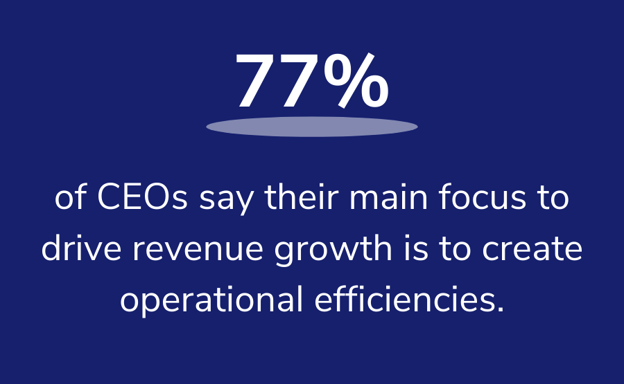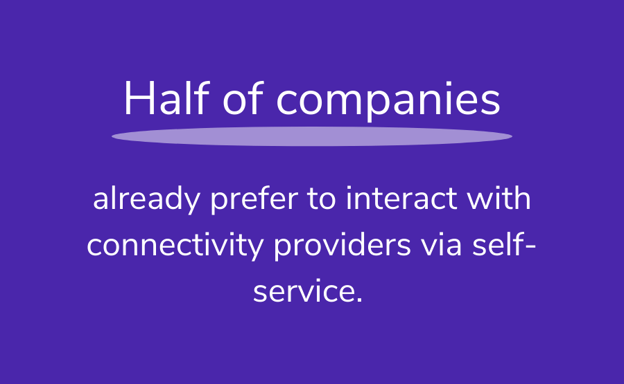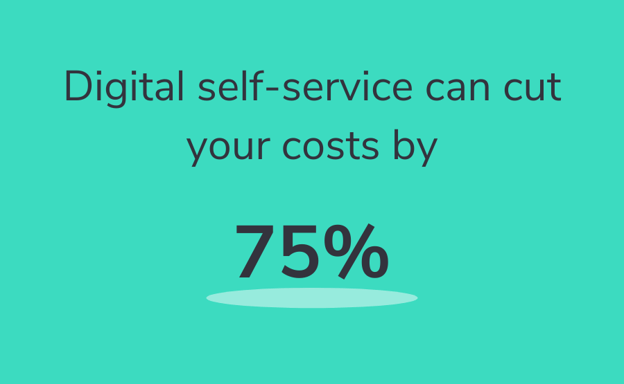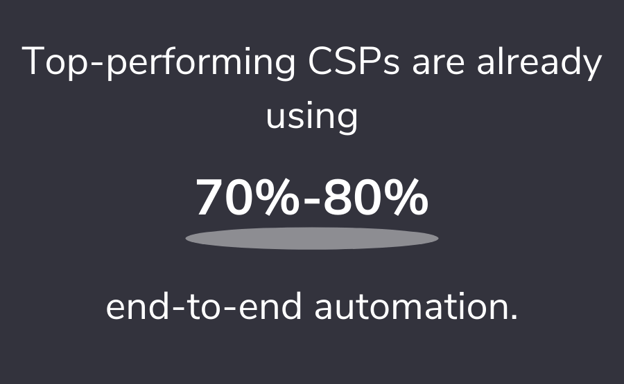Operational efficiency isn’t a glamorous initiative.
It doesn’t muster the same as excitement as a new product launch or next-gen tech feature.
But it’s time that changed.
Because for any Telco looking for ways to increase revenues in your B2B business, there’s no clearer strategy.
According to PwC, 77% of CEOs say their main focus to drive revenue growth is to create operational efficiencies.

So how can Communications providers make more of operational efficiencies on the B2B side of your business and boost profits in the process?
We’ve covered four strategies to get you started.
Shift to self-service
Done well, digital self-service gives your customers the control they crave, making it a staple of any convenient customer experience (cx).
Half of companies already prefer to interact with connectivity providers via self-service.

We’ve all grown used to doing just about everything via self-service. Your customers want the same option to handle their telecom transactions online or via mobile. It gives them visibility and control of their transactions, plus quicker resolutions to their queries. Whether that’s troubleshooting connectivity issues or tracking their usage.
Aside from improving your cx, there’s another gold-plated benefit.
Digital self-service can cut your costs by 75%.

Unassisted channels slash your support costs by downsizing call center operations and freeing up your team to focus on more valuable transactions.
Amazon claims a 95 percent success rate through its investment in self-service. The vast majority of its help center visitors are served without needing to switch to an assisted channel.
Despite the relative complexity of your services, CSPs need to follow suit and accelerate the adoption of automation and self-service capabilities.
Helping your customers succeed online starts with an easy and intuitive self-care experience. We’ve explored the staples of a seamless self-service experience, including eliminating any points of friction and creating personalized engagements.
For your B2B customers it’s about finding the right balance. As complexity and risk rises, people are more prone to reach for the safety blanket of your sales or customer support teams.
But even complex B2B journeys can benefit from making parts of the customer journey self-service. It gives your customers the best of both worlds – some of the control they’ve grown used to, with the safety net of your expertise.
Combine your sales & support channels
Your customer service is the face of your company.
If it’s disconnected from the rest of your channels, you’ll suffer from operational inefficiencies, disjointed customer experiences and miss opportunities to increase revenue.
You need your sales and customer service teams to work together, sharing the burden of keeping your customers happy. To build this productive partnership you ultimately need a 360-degree view of your customer and commercial data, plus the tools to make the most of it.
Visibility of a customer’s details, history and interactions can help turn your support channels into a profit center. Access to the right data gives your agents the information they need to not only fix problems, but identify relevant cross and up-sells – hiking revenues in the process.
As we’ve already touched on, CSPs can also achieve this shift by employing rich self-care capabilities and automation strategies.
Consolidate business processes through automation
If your teams are weighed down by repetitive admin duties, errors will soon creep in and your operational efficiency will suffer.
Automation can handle up to 45% of repetitive work, so you can use it to replace labour-intensive processes – whether that’s automating discounts and promotions, or order fulfillment and billing.
McKinsey says top-performing CSPs are already using 70% to 80% end-to-end automation, and that a target of fulfilling 80% to 90% of service requests digitally is realistic.

So start with looking at your processes from start to finish. From initial quote to ongoing orders. What’s eating into your productivity and where can automation speed up the value chain?
Once you’ve figured out what’s draining your resources, you can start using automation.
CSPs that use automated platforms can also leverage AI and machine learning to orchestrate your order fulfillment.
The result? Fewer errors, happier customers and no lost revenue.
40% of executives, largely from the telecom’s industry say they have already gained substantial benefits from cognitive technologies.
We’ve seen VodafoneZiggo take away the inherent complexity of telco from its users and make it as easy as possible for customers and partners to advance through the sales process using automated processes.
This approach is simplifying the sales process helping them increase sales, reduce overheads and, best of all, boost revenues.
Simplify systems
You’re facing competition from traditional competitors as well as OTT players, cloud-based service providers and new entrants to the market with leaner operating systems.
This fierce competition means developing digital channels and improving your cx should sit top of your priorities.
But trying to achieve these aims with vertical and product-specific solutions is a losing battle.
Ageing manual systems are holding CSPs back from increasing operational efficiencies. They breed slow time-to-market and limited visibility across customer and commercial data – delivering fragmented experiences, rather than digital-first ones.
Instead of building more custom solutions and adding more complexity, the right play is replacing siloed systems and simplifying your IT systems for leaner and more agile processes.
This will also help you open up digital channels that promote self-service and automation.
The following solutions can act as a bedrock to simplify your systems:
- A unified Product Catalog to remove the need for constant IT assistance and make it easy and cost-efficient to offer bundles, launch new products or change existing offerings
- Configure Price Quote (CPQ) functionality will increase the speed and accuracy of the sales process and power your self-service.
- An Order Management system will centralize order details and commercial data to make sure every order is accurately fulfilled. Improving the customer experience and reducing the risk of errors to minimize costs.
- A Contract Lifecycle Management system will give you the piece of mind knowing that your contracts are automated – streamlining the sales process even further.
Implementing these systems, together or as required, will give you the technological basis to transform your operational efficiencies. From there, it's a one-way ticket to increased revenues.
For more strategies for Telecommunications success, plus the technology that can help you deliver them, check out our free definitive guide for modern communication service providers
.png?width=200&height=103&name=CloudSense%20-%20TelcoDR%20(white%20no%20background).png)
















